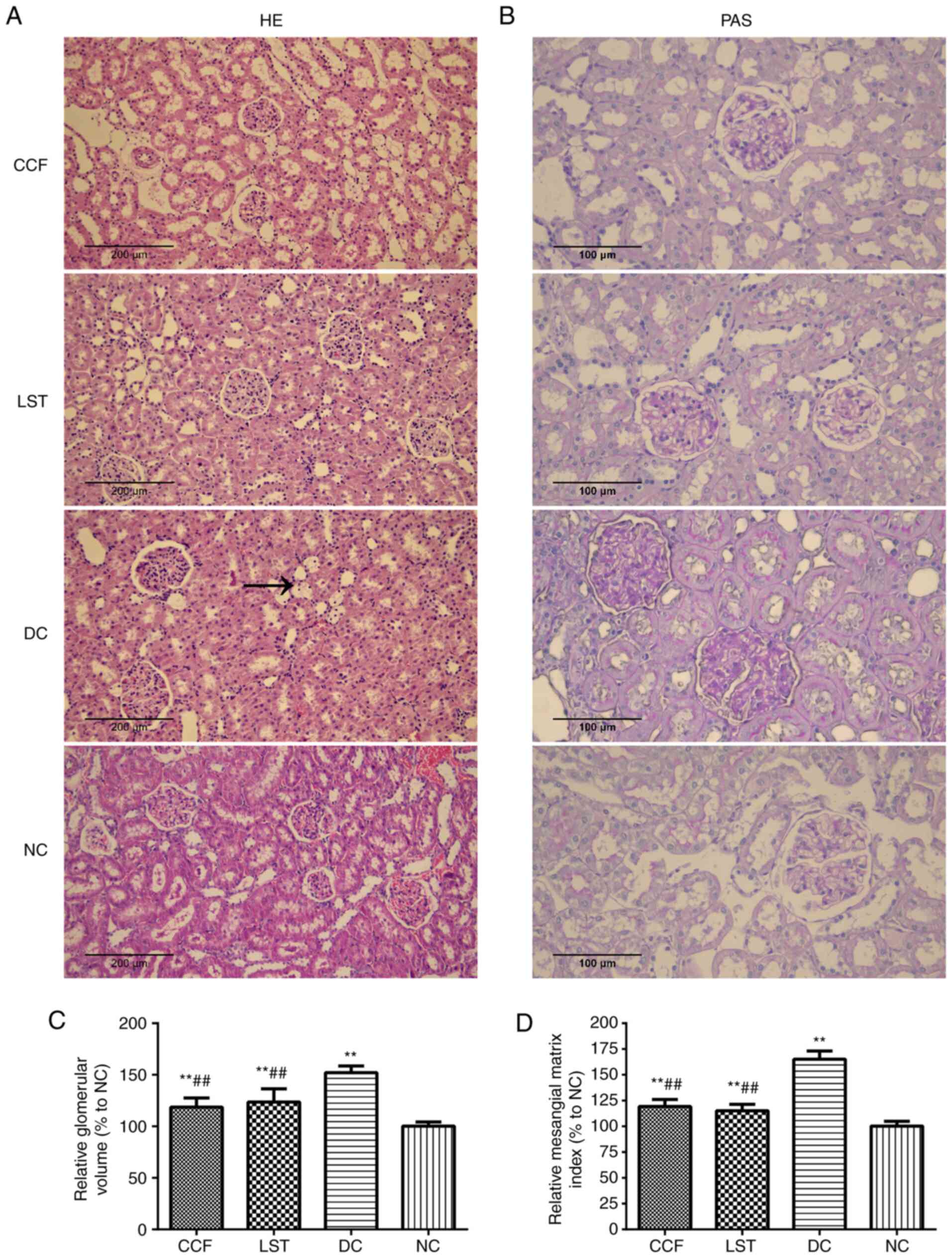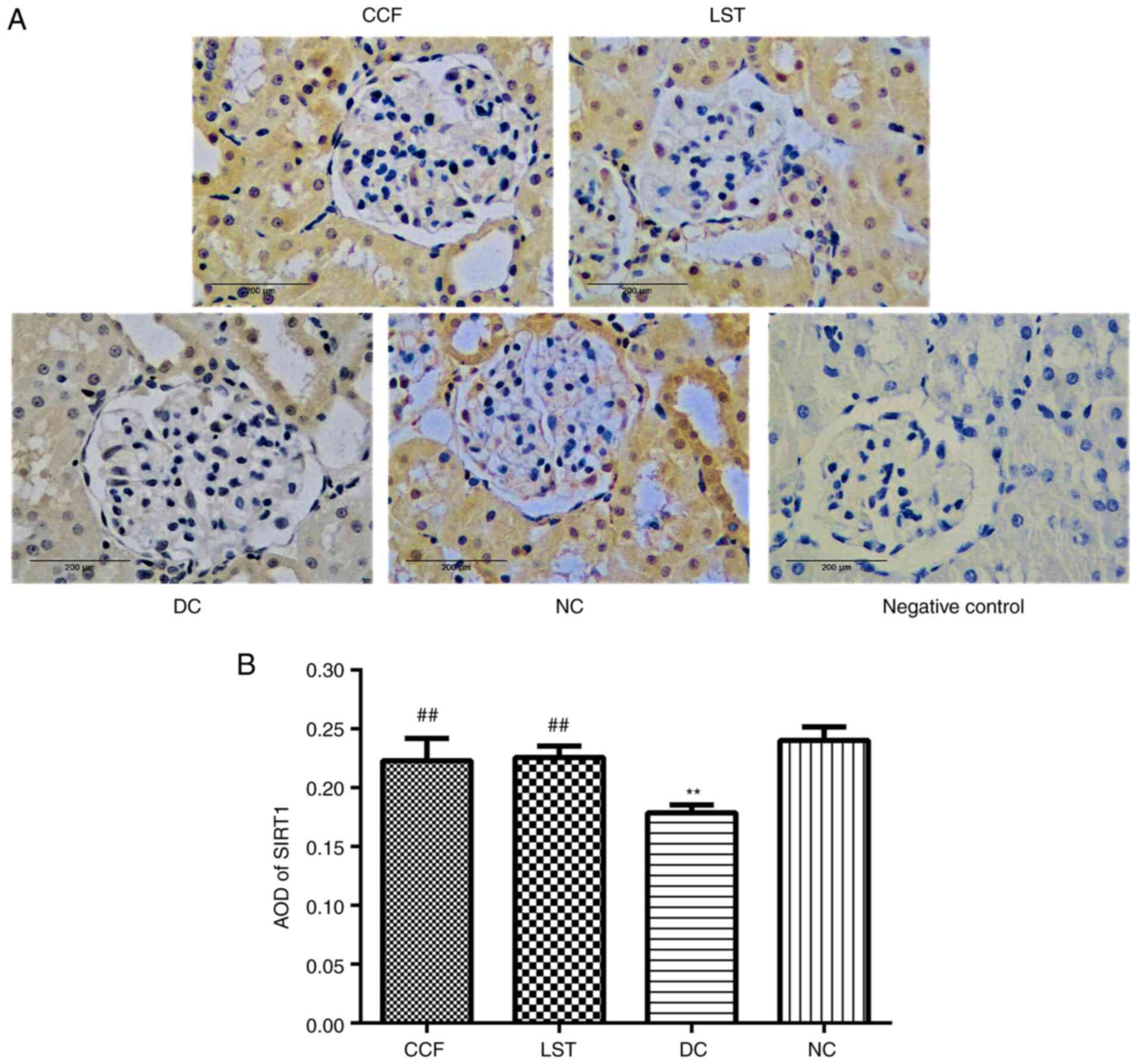|
1
|
König A, Schwarzinger B, Stadlbauer V,
Lanzerstorfer P, Iken M, Schwarzinger C, Kolb P, Schwarzinger S,
Mörwald K, Brunner S, et al: Guava (Psidium guajava) fruit extract
prepared by supercritical CO2 extraction inhibits
intestinal glucose resorption in a double-blind, randomized
clinical study. Nutrients. 11(1512)2019.PubMed/NCBI View Article : Google Scholar
|
|
2
|
Bakris GL, Hahr A, Khardori R, Koya D,
Molitch M, Prischl FC, Schernthaner G and Thajudeen B: Managing
diabetic nephropathies in clinical practice. Overview of diabetic
nephropathy. 10.1007/978-3-319-08873-0: 1-21, 2017.
|
|
3
|
Varga ZV, Giricz Z, Liaudet L, Haskó G,
Ferdinandy P and Pacher P: Interplay of oxidative,
nitrosative/nitrative stress, inflammation, cell death and
autophagy in diabetic cardiomyopathy. Biochim Biophys Acta.
1852:232–242. 2014.PubMed/NCBI View Article : Google Scholar
|
|
4
|
Flyvbjerg A: The role of the complement
system in diabetic nephropathy. Nat Rev Nephrol. 13:311–318.
2017.PubMed/NCBI View Article : Google Scholar
|
|
5
|
Choi JS, Kim J, Park J, Pyo S, Hong YK, Ku
S and Kim MR: Blood glycemia-modulating effects of melanian snail
protein hydrolysates in mice with type II diabetes. Int J Mol Med.
39:1437–1451. 2017.PubMed/NCBI View Article : Google Scholar
|
|
6
|
Mizuno Y, Yamamotoya T, Nakatsu Y, Ueda K,
Matsunaga Y, Inoue MK, Sakoda H, Fujishiro M, Ono H, Kikuchi T, et
al: Xanthine oxidase inhibitor febuxostat exerts an
anti-inflammatory action and protects against diabetic nephropathy
development in KK-Ay obese diabetic mice. Int J Mol Sci.
20(4680)2019.PubMed/NCBI View Article : Google Scholar
|
|
7
|
Rajesh M, Mukhopadhyay P, Bátkai S, Patel
V, Saito K, Matsumoto S, Kashiwaya Y, Horváth B, Mukhopadhyay B,
Becker L, et al: Cannabidiol attenuates cardiac dysfunction,
oxidative stress, fibrosis, and inflammatory and cell death
signaling pathways in diabetic cardiomyopathy. J Am Coll Cardiol.
56:2115–2125. 2010.PubMed/NCBI View Article : Google Scholar
|
|
8
|
Duecker R, Baer P, Eickmeier O, Strecker
M, Kurz J, Schaible A, Henrich D, Zielen S and Schubert R:
Oxidative stress-driven pulmonary inflammation and fibrosis in a
mouse model of human ataxia-telangiectasia. Redox Biol. 14:645–655.
2018.PubMed/NCBI View Article : Google Scholar
|
|
9
|
Valacchi G, Virgili F, Cervellati C and
Pecorelli A: OxInflammation: From subclinical condition to
pathological biomarker. Front Physiol. 9(858)2018.PubMed/NCBI View Article : Google Scholar
|
|
10
|
Bonkowski M and Sinclair D: Slowing ageing
by design: The rise of NAD+ and sirtuin-activating
compounds. Nat Rev Mol Cell Biol. 17:679–690. 2016.PubMed/NCBI View Article : Google Scholar
|
|
11
|
Guo R, Liu W, Liu B, Zhang B, Li W and Xu
Y: SIRT1 suppresses cardiomyocyte apoptosis in diabetic
cardiomyopathy: An insight into endoplasmic reticulum stress
response mechanism. Int J Cardiol. 191:36–45. 2015.PubMed/NCBI View Article : Google Scholar
|
|
12
|
Hao CM and Haase V: Sirtuins and their
relevance to the kidney. J Am Soc Nephrol. 21:1620–1627.
2010.PubMed/NCBI View Article : Google Scholar
|
|
13
|
Wakino S, Hasegawa K and Itoh H: Sirtuin
and metabolic kidney disease. Kidney Int. 88:691–698.
2015.PubMed/NCBI View Article : Google Scholar
|
|
14
|
Zhu Q, Zeng J, Li J, Chen X, Miao J, Jin Q
and Chen H: Effects of compound centella on oxidative stress and
Keap1-Nrf2-ARE pathway expression in diabetic kidney disease rats.
Evid Based Complement Alternat Med. 2020(9817932)2020.PubMed/NCBI View Article : Google Scholar
|
|
15
|
Mengjie Z, Ziyang B, Liqiang Y, Danfeng G,
Lin W and Jiao Z: Clinical Study on Modified Compound Jixuecao Tang
for Chronic Glomerulonephritis and Chronic Kidney Disease at the
Third Stage. Journal of New Chinese Medicine: 2019.
|
|
16
|
Spiers DE and Candas V: Relationship of
skin surface area to body mass in the immature rat: A
reexamination. J Appl Physiol Respir Environ Exerc Physiol.
56:240–243. 1984.PubMed/NCBI View Article : Google Scholar
|
|
17
|
Ding Y, Zhang R, Zhang K, Lv X, Chen Y, Li
A, Wang L, Zhang X and Xia Q: Nischarin is differentially expressed
in rat brain and regulates neuronal migration. PloS One.
8(e54563)2013.PubMed/NCBI View Article : Google Scholar
|
|
18
|
Zhu X, Chen Y, Chen Q, Yang H and Xie X:
Astaxanthin promotes Nrf2/ARE signaling to alleviate renal
fibronectin and collagen IV accumulation in diabetic rats. J
Diabetes Res. 2018(6730315)2018.PubMed/NCBI View Article : Google Scholar
|
|
19
|
Artacho-Perula E, Roldan-Villalobos R,
Salcedo-Leal I and Vaamonde-Lemos R: Stereological estimates of
volume-weighted mean glomerular volume in streptozotocin-diabetic
rats. Lab Invest. 68:56–61. 1993.PubMed/NCBI
|
|
20
|
Liu HF, Guo LQ, Huang YY, Chen K, Tao JL,
Li SM and Chen XW: Thiazolidinedione attenuate proteinuria and
glomerulosclerosis in Adriamycin-induced nephropathy rats via slit
diaphragm protection. Nephrology (Carlton). 15:75–83.
2010.PubMed/NCBI View Article : Google Scholar
|
|
21
|
Loeffler I and Wolf G: Pathophysiologie
der diabetischen Nephropathie. Der Nephrologe. 12:391–399.
2017.
|
|
22
|
Karolina L, Hannes O, Risul A, Arvind P,
Regina G, Taylor RF, Moosa M, Ann C, Karolina K and Larsson TE:
Arterial klotho expression and FGF23 effects on vascular
calcification and function. Plos One. 8(e60658)2013.PubMed/NCBI View Article : Google Scholar
|
|
23
|
Martynyuk L, Martynyuk L, Ruzhytska O and
Martynyuk O: Effect of the herbal combination canephron N on
diabetic nephropathy in patients with diabetes mellitus: Results of
a comparative cohort study. J Altern Complement Med. 20:472–478.
2014.PubMed/NCBI View Article : Google Scholar
|
|
24
|
Tavafi M: Diabetic nephropathy and
antioxidants. J Nephropathology. 2:20–27. 2013.PubMed/NCBI View Article : Google Scholar
|
|
25
|
Gosmanov AR, Wall BM and Gosmanova EO:
Diagnosis and treatment of diabetic kidney disease. Am J Med Sci.
347:406–413. 2014.PubMed/NCBI View Article : Google Scholar
|
|
26
|
Sego S: Pathophysiology of diabetic
nephropathy. Nephrol Nurs J. 34:631–633. 2008.PubMed/NCBI
|
|
27
|
Magalhães DA, Kume WT, Correia FS, Queiroz
TS, Allebrandt Neto EW, Santos MP, Kawashita NH and França SA:
High-fat diet and streptozotocin in the induction of type 2
diabetes mellitus: A new proposal. An Acad Bras Ciênc.
91(e20180314)2019.PubMed/NCBI View Article : Google Scholar
|
|
28
|
Guex CG, Reginato FZ, de Jesus PR,
Brondani JC, Lopes GH and Bauermann LF: Antidiabetic effects of
Olea europaea L. leaves in diabetic rats induced by high-fat
diet and low-dose streptozotocin. J Ethnopharmacol. 235:1–7.
2019.PubMed/NCBI View Article : Google Scholar
|
|
29
|
Ahad A, Ganai AA, Mujeeb M and Siddiqui
WA: Ellagic acid, an NF-κB inhibitor, ameliorates renal function in
experimental diabetic nephropathy. Chemico-Biological Interactions.
219:64–75. 2014.PubMed/NCBI View Article : Google Scholar
|
|
30
|
Ahad A, Ganai AA, Mujeeb M and Siddiqui
WA: Chrysin, an anti-inflammatory molecule, abrogates renal
dysfunction in type 2 diabetic rats. Toxicol Appl Pharmacol.
279:1–7. 2014.PubMed/NCBI View Article : Google Scholar
|
|
31
|
Serdar M, Sertoglu E, Uyanik M, Tapan S,
Bilgi C and Kurt I: Comparison of 8-hydroxy-2'-deoxyguanosine
(8-OHdG) levels using mass spectrometer and urine albumin
creatinine ratio as a predictor of development of diabetic
nephropathy. Free Radic Res. 46:1291–1295. 2012.PubMed/NCBI View Article : Google Scholar
|
|
32
|
Yang M, Jun L, Zhou X, Ding H, Xu J, Yang
B, Sun B, Xiao D, Yu J and Gong Q: Correlation analysis between
serum vitamin D levels and lower extremity macrovascular
complications in individuals with type 2 diabetes mellitus. J
Diabetes Res. 2019(4251829)2019.PubMed/NCBI View Article : Google Scholar
|
|
33
|
Lampropoulou IT, Stangou M, Papagianni A,
Didangelos T, Iliadis F and Efstratiadis G: TNF-α and
microalbuminuria in patients with type 2 diabetes mellitus. J
Diabetes Res. 2014(394206)2014.PubMed/NCBI View Article : Google Scholar
|
|
34
|
Malikova J, Zdarilova A and Hlobilkova A:
Effects of sanguinarine and chelerythrine on the cell cycle and
apoptosis. Biomed Pap Med Fac Univ Palacky Olomouc Czech Repub.
150:5–12. 2006.PubMed/NCBI View Article : Google Scholar
|
|
35
|
Liu T, Zhang L, Joo D and Sun SC: NF-κB
signaling in inflammation. Signal Transduct Target Ther.
2(17023)2017.PubMed/NCBI View Article : Google Scholar
|
|
36
|
Xu XY and Ye SW: Efficacy assessment of
treating post-stroke shoulder-hand syndrome patients of yin
deficiency yang hyperactivity with blood stasis stagnation
collaterals syndrome by yishen tongluo decoction. Zhongguo Zhong Xi
Yi Jie He Za Zhi. 34:1069–1073. 2014.PubMed/NCBI(Article in Chinese).
|
|
37
|
Kalantarinia K, Awad AS and Siragy HM:
Urinary and renal interstitial concentrations of TNF-α increase
prior to the rise in albuminuria in diabetic rats. Kidney Int.
64:1208–1213. 2003.PubMed/NCBI View Article : Google Scholar
|
|
38
|
Takebayashi K, Matsumoto S, Aso Y and
Inukai T: Aldosterone blockade attenuates urinary monocyte
chemoattractant protein-1 and oxidative stress in patients with
type 2 diabetes complicated by diabetic nephropathy. J Clin
Endocrinol Metab. 91:2214–2217. 2006.PubMed/NCBI View Article : Google Scholar
|
|
39
|
Kowalczuk K and Stryjecka-Zimmer M: The
influence of oxidative stress on the level of malondialdehyde (MDA)
in different areas of the rabbit brain. Ann Univ Mariae Curie
Sklodowska Med. 57:160–164. 2002.PubMed/NCBI
|
|
40
|
Kaefer M, De Carvalho JA, Piva SJ, da
Silva DB, Becker AM, Sangoi MB, Almeida TC, Hermes CL, Coelho AC,
Tonello R, et al: Plasma malondialdehyde levels and risk factors
for the development of chronic complications in type 2 diabetic
patients on insulin therapy. Clin Lab. 58:973–978. 2012.PubMed/NCBI
|
|
41
|
Li X, Cai W, Lee K, Liu B, Deng Y, Chen Y,
Zhang X, He J and Zhong Y: Puerarin attenuates diabetic kidney
injury through the suppression of NOX4 expression in podocytes. Sci
Rep. 7(14603)2017.PubMed/NCBI View Article : Google Scholar
|
|
42
|
Ribaldo PD, Souza DS, Biswas SK, Block K,
Faria J, Lopes de Faria JM and Lopes de Faria JB: Green tea
(Camellia sinensis) attenuates nephropathy by downregulating
Nox4 NADPH oxidase in diabetic spontaneously hypertensive rats. J
Nutr. 139:96–100. 2009.PubMed/NCBI View Article : Google Scholar
|
|
43
|
Peng Q, Liu F and Liang X: Superoxide
dismutase and plant resistance to the environmental stress.
Heilongjiang Agricultural Science. 1:31–34. 2002.
|
|
44
|
Samarghandian S, Borji A, Delkhosh M and
Samini F: Safranal treatment improves hyperglycemia, hyperlipidemia
and oxidative stress in streptozotocin-induced diabetic rats. J
Pharm Pharm Sci. 16:352–362. 2013.PubMed/NCBI View Article : Google Scholar
|
|
45
|
Tisato V, Gallo S, Melloni E, Celeghini C,
Passaro A, Zauli G, Secchiero P, Bergamini C, Trentini A,
Bonaccorsi G, et al: TRAIL and ceruloplasmin inverse correlation as
a representative crosstalk between inflammation and oxidative
stress. Mediators Inflamm. 2018(9629537)2018.PubMed/NCBI View Article : Google Scholar
|
|
46
|
Elmarakby AA and Sullivan JC: Relationship
between oxidative stress and inflammatory cytokines in diabetic
nephropathy. Cardiovasc Ther. 30:49–59. 2012.PubMed/NCBI View Article : Google Scholar
|
|
47
|
Webster BR, Lu Z, Sack MN and Scott I: The
role of sirtuins in modulating redox stressors. Free Radical Biol
Med. 52:281–290. 2011.PubMed/NCBI View Article : Google Scholar
|
|
48
|
Yang X, Zhang B, Lu X, Yan M, Wen Y, Zhao
T and Li P: Effects of Tangshen Formula on urinary and plasma
liver-type fatty acid binding protein levels in patients with type
2 diabetic kidney disease: Post-hoc findings from a multi-center,
randomized, double-blind, placebo-controlled trial investigating
the efficacy and safety of Tangshen Formula in patients with type 2
diabetic kidney disease. BMC Complement Altern Med.
16(246)2016.PubMed/NCBI View Article : Google Scholar
|
|
49
|
Iskender H, Dokumacioglu E, Sen TM, Ince
I, Kanbay Y and Saral S: The effect of hesperidin and quercetin on
oxidative stress, NF-κB and SIRT1 levels in a STZ-induced
experimental diabetes model. Biomed Pharmacother. 90:500–508.
2017.PubMed/NCBI View Article : Google Scholar
|
|
50
|
Huang K, Gao X and Wei W: The crosstalk
between Sirt1 and Keap1/Nrf2/ARE anti-oxidative pathway forms a
positive feedback loop to inhibit FN and TGF-β1 expressions in rat
glomerular mesangial cells. Exp Cell Res. 361:63–72.
2017.PubMed/NCBI View Article : Google Scholar
|
|
51
|
Du YG, Zhang KN, Gao ZL, Dai F, Wu XX and
Chai KF: Tangshen formula improves inflammation in renal tissue of
diabetic nephropathy through SIRT1/NF-κB pathway. Exp Ther Med.
15:2156–2164. 2018.PubMed/NCBI View Article : Google Scholar
|


















